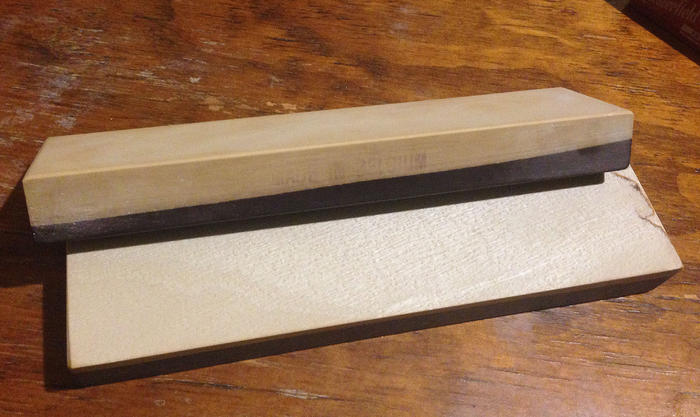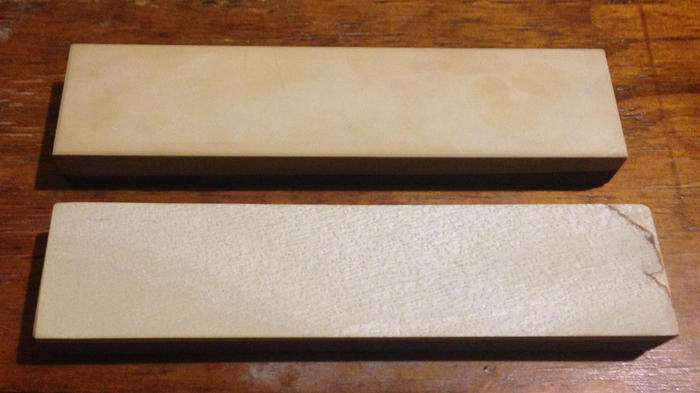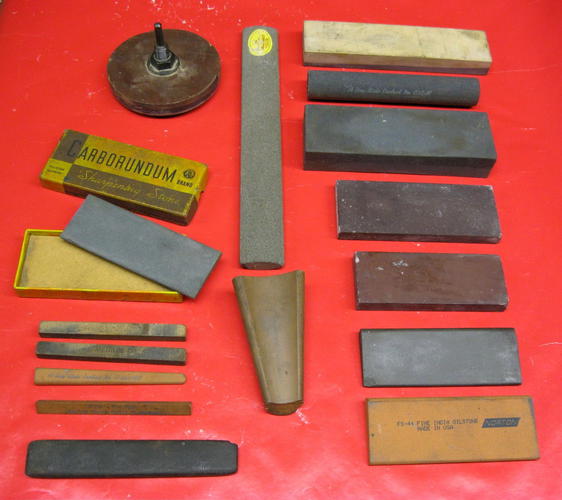Results 1 to 8 of 8
 7Likes
7Likes
Thread: Help ID on this coticule
-
03-28-2015, 06:15 AM #1Member

- Join Date
- Jun 2013
- Location
- Toluca, Mexico
- Posts
- 56
Thanked: 1 Help ID on this coticule
Help ID on this coticule
Hello all
I just got this Belgian natural combo (the one on the top) which has a very smooth feel and has no texture compared to the other one in the picture which by the way has some glittering spots. The dimensions are 175 mm x 42 mm x 19mm and also looks like a rarely used stone. Notice the stamp: "made in Belgium" Any info appreciated.
Thanks and sorry for the phone-picures that I will update with better ones if it gets some interest.


-
03-28-2015, 06:48 AM #2illegitimum non carborundum



- Join Date
- Jan 2008
- Location
- Rochester, MN
- Posts
- 11,552
- Blog Entries
- 1
Thanked: 3795
I'm going to go out on a limb and say they are both coticules. If you want to know more about them, start honing!
-
03-28-2015, 09:46 AM #3

Yeah they both look like coticules. The stamp on the upper hone indicates that it is a ancient one because Maurice don't stamp his newly mined coticules nowadays.
Thereore all thoughts about layers are only guesses. Both hones look very good, no cracks and inclusions on the main working area visible. So test and enjoy them. Good catch!
-
03-28-2015, 01:07 PM #4Historically Inquisitive



- Join Date
- Aug 2011
- Location
- Upstate New York
- Posts
- 5,782
- Blog Entries
- 1
Thanked: 4249
Also note that it is a "Natural combo" coticule, and a really thick one for sure, Enjoy!
-
03-28-2015, 01:15 PM #5I used Nakayamas for my house



- Join Date
- Aug 2009
- Location
- Des Moines
- Posts
- 8,664
- Blog Entries
- 1
Thanked: 2591
Just by looks it is impossible to tell more than it is a Coticule. When you hone on them you will know where they fall as far as razor honing.
There is no way on earth to tell the strata if that was your original question.Stefan
-
03-28-2015, 01:29 PM #6

When I first saw Belgian coticules @ barber shops in the 1980s, they were invariably ink stamped on one, or both sides, with 'Made In Belgium.' When that practice started, or when it ended is unknown to me. How long those old guys had their coticules is also a question I didn't get an answer to.
I have two 5x2&1/2 that are stamped like that, and one that is not. So in one sense it is older than the current production of Ardennes, but in another sense, they are all ancient rocks, regardless of when they were dug out of the ground.
Some guys think that the 'older' production was probably better because there were more veins of coticule, or Arkansas, or whatever, but it could very well be that the veins that are exposed and harvested now are better yet. Mother nature deposited the material without discriminating. Hope you've gotten a good one.Be careful how you treat people on your way up, you may meet them again on your way back down.
-
03-28-2015, 02:16 PM #7Senior Member

- Join Date
- Sep 2013
- Location
- NW Indiana
- Posts
- 1,060
Thanked: 246
Definitely agree. The "old stone veins are so much better" line is a crock IMO. The stone gets dug from the ground as it is reached. There's no way to test the properties of the stone before digging it up. Even if one were to cut core samples by drilling, since the stone is natural and varies it may be considerably different even a foot away from the site of the core. It's complete random chance whether one stone is better than another. Now perhaps in the olden days when the price of labor was so much cheaper they may have done better quality control and tested and rejected many of the same type/quality of stones that get sold today, but there's no way to know that now.
-
04-02-2015, 05:00 AM #8Member

- Join Date
- Jun 2013
- Location
- Toluca, Mexico
- Posts
- 56
Thanked: 1
Update: A quick and hard hone, very hard to get slurry. For less than 60 bucks and another unknown hones, who can complain?




 LinkBack URL
LinkBack URL About LinkBacks
About LinkBacks






 Reply With Quote
Reply With Quote

